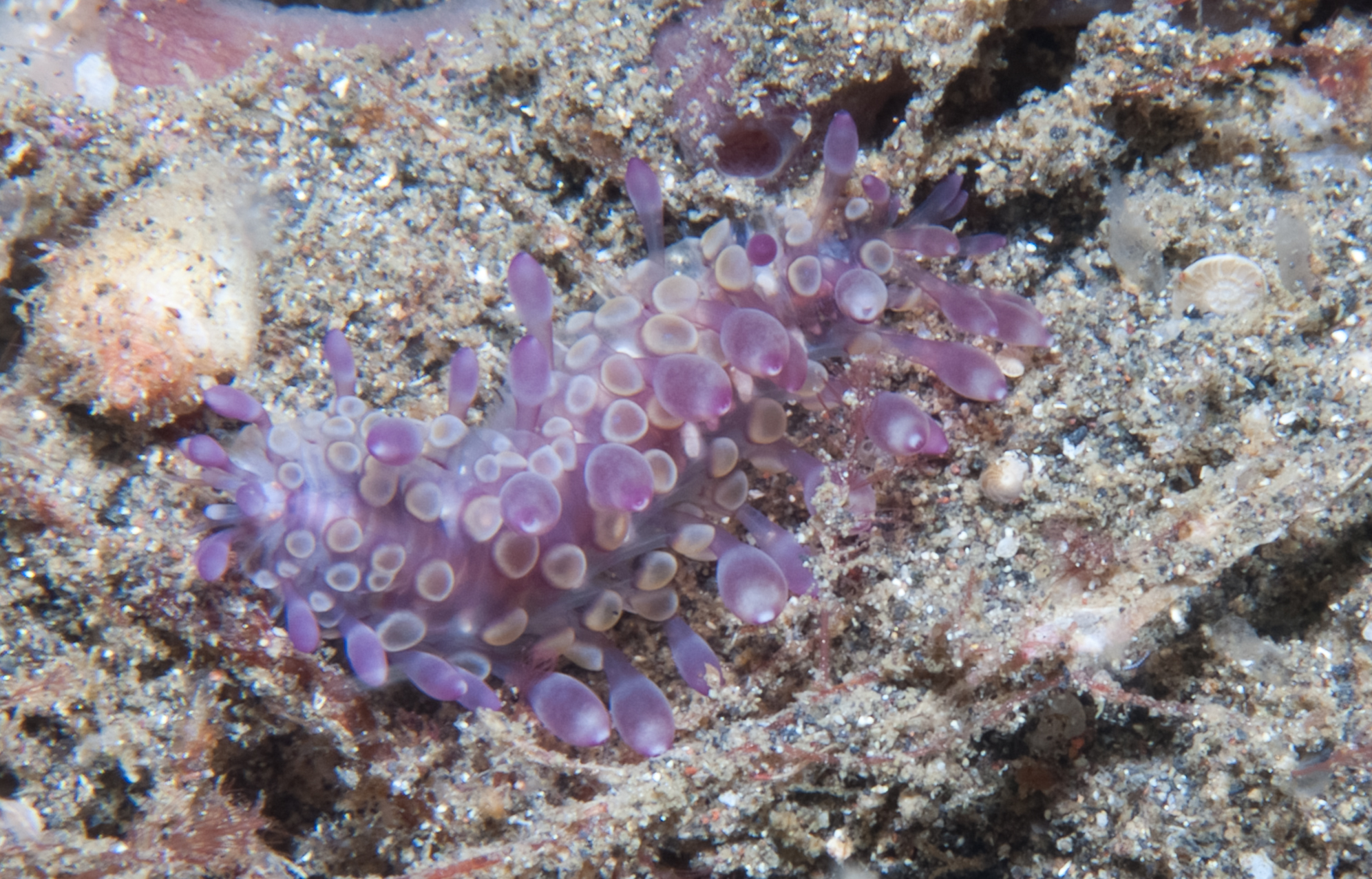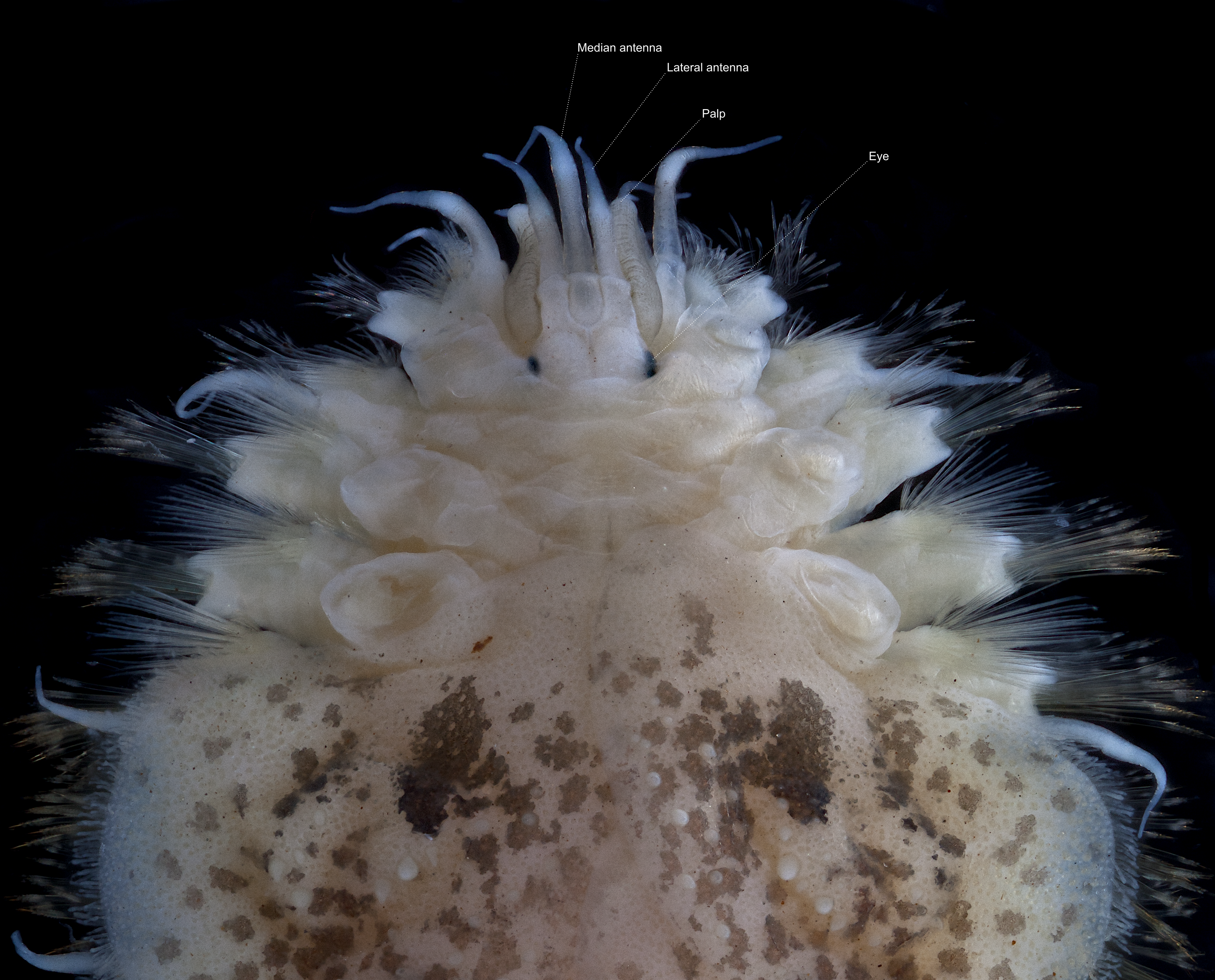|
Subadyte Micropapillata
''Subadyte'' is a genus of marine polychaete worms belonging to the family Polynoidae, the scaleworms. Eight species of ''Subadyte'' are recognised and the genus is known to occur widely in the world's oceans from the intertidal zone to depths of about 1200 m.Pettibone, Marian H. 1969. Review of some species referred to Scalisetosus McIntosh (Polychaeta, Polynoidae). Proceedings of the Biological Society of Washington, 82: 1–30., available online at http://hdl.handle.net/10088/3412Hanley, J.R. & Burke, M. (1991) Polychaeta Polynoidae: Scaleworms of the Chesterfield Island and Fairway Reefs, Coral Sea. In: A. Crosnier (ed.), Résultats des Campagnes MUSORSTOM, Volume 8. Mémoires du Muséum national d’Histoire naturelle. Série A, Zoologie 151, 9–82. Description ''Subadyte'' are short-bodied worms with around 35–41 segments and 15–16 pairs of elytra. The lateral antennae are positioned ventrally on the prostomium, directly beneath the median antenna and the neurochaetae ... [...More Info...] [...Related Items...] OR: [Wikipedia] [Google] [Baidu] [Amazon] |
|
 |
Polynoidae
Polynoidae is a family (biology), family of marine Polychaete worms known as "scale worms" due to the scale-like elytron (Annelida), elytra on the dorsal surface. Almost 900 species are currently recognised belonging to 9 subfamilies and 167 genera. They are active hunters, but generally dwell in protected environments such as under stones. The group is widely distributed from shallow Intertidal zone, intertidal waters to Hadal zone, hadal trenches. They are the most diverse group of polychaetes in terms of genus number and second most diverse in terms of species number which is almost 8% of all segmented worm species. Description Most Polynoidae species are short and flattened, but can reach as much as 20 cm in length and 10 cm width in ''Eulagisca gigantea'' and ''Eulagisca uschakovi''. Individuals are usually covered almost entirely by Elytron (Annelida), elytra, which can be shed and regenerated in many species. The elytra of some species are faintly bioluminescent ... [...More Info...] [...Related Items...] OR: [Wikipedia] [Google] [Baidu] [Amazon] |
 |
Intertidal Zone
The intertidal zone or foreshore is the area above water level at low tide and underwater at high tide; in other words, it is the part of the littoral zone within the tidal range. This area can include several types of habitats with various species of life, such as sea stars, sea urchins, and many species of coral with regional differences in biodiversity. Sometimes it is referred to as the ''littoral zone'' or '' seashore'', although those can be defined as a wider region. The intertidal zone also includes steep rocky cliffs, sandy beaches, bogs or wetlands (e.g., vast mudflats). This area can be a narrow strip, such as in Pacific islands that have only a narrow tidal range, or can include many meters of shoreline where shallow beach slopes interact with high tidal excursion. The peritidal zone is similar but somewhat wider, extending from above the highest tide level to below the lowest. Organisms in the intertidal zone are well-adapted to their environment, facing high ... [...More Info...] [...Related Items...] OR: [Wikipedia] [Google] [Baidu] [Amazon] |
 |
Elytron (Annelida)
In annelids, elytra (; from Greek Greek may refer to: Anything of, from, or related to Greece, a country in Southern Europe: *Greeks, an ethnic group *Greek language, a branch of the Indo-European language family **Proto-Greek language, the assumed last common ancestor of all kno ... ἔλυτρον "sheath, cover"; : elytron ) are shield-like scales that are attached dorsally, one pair on each of a number of alternating segments and entirely or partly cover the dorsum. Elytra are modified dorsal cirri, and their number, size, location, and ornamentation are important taxonomic characters. The basal part of the elytra is known as the elytrophore; if (as is often the case) elytra are lost their presence is indicated by the elytrophore which is still present and visible. Annelids possessing elytra are also known as "scale worms". Possession of elytra is characteristic of the annelid suborder Aphroditiformia. Gallery File:Eunoe leiotentaculata lower res.jpg, A '' Eunoe leioten ... [...More Info...] [...Related Items...] OR: [Wikipedia] [Google] [Baidu] [Amazon] |
 |
Prostomium
The prostomium (From Ancient Greek, meaning "before the mouth"; : prostomia; sometimes also called the "acron") is the Cephalization, cephalized first body segment in an annelid worm's body at the anterior end. It is in front of (but does not include) the mouth, being usually a small shelf- or lip-like extension over the dorsal side of the mouth. The prostomium together with the peristomium, which includes the mouth and pharynx#Invertebrates, pharynx, make up the annelid head. Description The prostomium is part of the head and holds at least part of the brain and often bears sensory structures such as the simple eye in invertebrates, eyes, antenna (biology), antennae and palps. It may function like a kind of overlip when the animal is feeding. The prostomium bears many important taxonomic characters and its shape and composition are important for annelid systematics. In addition to the eyes, antennae and palps, the prostomium can possess appendages such as tentacles or cirrus ... [...More Info...] [...Related Items...] OR: [Wikipedia] [Google] [Baidu] [Amazon] |
 |
Chaeta
A chaeta or cheta (; ) is a chitinous bristle or seta found on annelid worms, although the term is also frequently used to describe similar structures in other invertebrates such as arthropods. Polychaete annelids (''polychaeta'' literally meaning "many bristles") are named for their chaetae. In Polychaeta, chaetae are found as bundles on the parapodia, paired appendages on the side of the body. The chaetae are epidermal, extracellular This glossary of biology terms is a list of definitions of fundamental terms and concepts used in biology, the study of life and of living organisms. It is intended as introductory material for novices; for more specific and technical definitions ... structures, and clearly visible in most polychaetes. They are probably the best-studied structures in these animals. Segments bearing chaetae are called chaetigers. Use in taxonomy and identification The ultrastructure of chaetae is fundamentally similar for all taxa but there is vast diversity ... [...More Info...] [...Related Items...] OR: [Wikipedia] [Google] [Baidu] [Amazon] |
|
Subadyte Albanyensis
''Subadyte'' is a genus of marine polychaete worms belonging to the family Polynoidae, the scaleworms. Eight species of ''Subadyte'' are recognised and the genus is known to occur widely in the world's oceans from the intertidal zone to depths of about 1200 m.Pettibone, Marian H. 1969. Review of some species referred to Scalisetosus McIntosh (Polychaeta, Polynoidae). Proceedings of the Biological Society of Washington, 82: 1–30., available online at http://hdl.handle.net/10088/3412Hanley, J.R. & Burke, M. (1991) Polychaeta Polynoidae: Scaleworms of the Chesterfield Island and Fairway Reefs, Coral Sea. In: A. Crosnier (ed.), Résultats des Campagnes MUSORSTOM, Volume 8. Mémoires du Muséum national d’Histoire naturelle. Série A, Zoologie 151, 9–82. Description ''Subadyte'' are short-bodied worms with around 35–41 segments and 15–16 pairs of elytra. The lateral antennae are positioned ventrally on the prostomium, directly beneath the median antenna and the neurochaetae ... [...More Info...] [...Related Items...] OR: [Wikipedia] [Google] [Baidu] [Amazon] |
|
|
Subadyte Mexicana
''Subadyte'' is a genus of marine polychaete worms belonging to the family Polynoidae, the scaleworms. Eight species of ''Subadyte'' are recognised and the genus is known to occur widely in the world's oceans from the intertidal zone to depths of about 1200 m.Pettibone, Marian H. 1969. Review of some species referred to Scalisetosus McIntosh (Polychaeta, Polynoidae). Proceedings of the Biological Society of Washington, 82: 1–30., available online at http://hdl.handle.net/10088/3412Hanley, J.R. & Burke, M. (1991) Polychaeta Polynoidae: Scaleworms of the Chesterfield Island and Fairway Reefs, Coral Sea. In: A. Crosnier (ed.), Résultats des Campagnes MUSORSTOM, Volume 8. Mémoires du Muséum national d’Histoire naturelle. Série A, Zoologie 151, 9–82. Description ''Subadyte'' are short-bodied worms with around 35–41 segments and 15–16 pairs of elytra. The lateral antennae are positioned ventrally on the prostomium, directly beneath the median antenna and the neurochaetae ... [...More Info...] [...Related Items...] OR: [Wikipedia] [Google] [Baidu] [Amazon] |
|
|
Subadyte Micropapillata
''Subadyte'' is a genus of marine polychaete worms belonging to the family Polynoidae, the scaleworms. Eight species of ''Subadyte'' are recognised and the genus is known to occur widely in the world's oceans from the intertidal zone to depths of about 1200 m.Pettibone, Marian H. 1969. Review of some species referred to Scalisetosus McIntosh (Polychaeta, Polynoidae). Proceedings of the Biological Society of Washington, 82: 1–30., available online at http://hdl.handle.net/10088/3412Hanley, J.R. & Burke, M. (1991) Polychaeta Polynoidae: Scaleworms of the Chesterfield Island and Fairway Reefs, Coral Sea. In: A. Crosnier (ed.), Résultats des Campagnes MUSORSTOM, Volume 8. Mémoires du Muséum national d’Histoire naturelle. Série A, Zoologie 151, 9–82. Description ''Subadyte'' are short-bodied worms with around 35–41 segments and 15–16 pairs of elytra. The lateral antennae are positioned ventrally on the prostomium, directly beneath the median antenna and the neurochaetae ... [...More Info...] [...Related Items...] OR: [Wikipedia] [Google] [Baidu] [Amazon] |